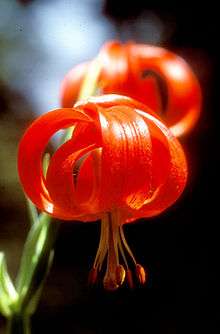Lilium chalcedonicum
| Lilium chalcedonicum | |
|---|---|
 | |
| Lilium chalcedonicum | |
| Scientific classification | |
| Kingdom: | Plantae |
| (unranked): | Angiosperms |
| (unranked): | Monocots |
| Order: | Liliales |
| Family: | Liliaceae |
| Genus: | Lilium |
| Species: | L. chalcedonicum |
| Binomial name | |
| Lilium chalcedonicum L. | |
| Synonyms[1] | |
| |
Lilium chalcedonicum is a bulbous European plant native to Tuscany, Greece and Albania.[1][2] It grows up to 1.5 metre high, though usually rather less. It bears reflexed and nodding flowers, usually red or orange, not spotted, but with warts toward the base of the perianth segments.[3]
In the Victorian language of flowers, lilies portray love, ardor, and affection for your loved ones, while orange lilies stand for happiness, love, and warmth.[4]
References
- 1 2 Kew World Checklist of Selected Plant Families
- 1 2 Altervista Flora Italiana, Giglio del Bosforo. Lilium calcedonicum L.
- ↑ European Garden Flora; vol. 1.
- ↑ "Symbolism of the Lily - The Flower That is a Part of History". Buzzle. Retrieved 2016-11-26.
| Wikimedia Commons has media related to Lilium chalcedonicum. |
This article is issued from Wikipedia - version of the 11/26/2016. The text is available under the Creative Commons Attribution/Share Alike but additional terms may apply for the media files.